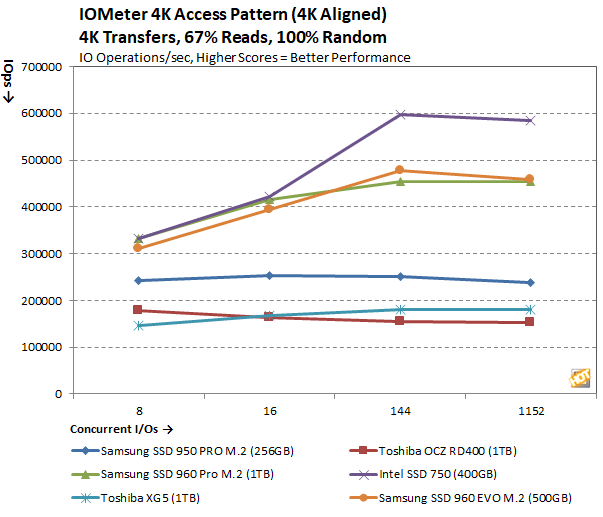Toshiba XG5 NVMe SSD Review: Strong Performance With 64-Layer BiCS 3D Flash
Toshiba XG5 - Test Setup, IOMeter 1.1, Compression Tests
Our Test Methodologies: Under each test condition, the Solid State Drives tested here were installed as secondary volumes in our testbed, with a separate drive used for the OS and benchmark installations. Out testbed's motherboard was updated with the latest BIOS available at the time of publication and AHCI (or RAID) mode was enabled.
The SSDs were secure erased prior to testing, and left blank without partitions for some tests, while others required them to be partitioned and formatted, as is the case with the ATTO, PCMark, and CrystalDiskMark benchmark tests. Windows firewall, automatic updates and screen savers were all disabled before testing and Quiet Hours was enabled. In all test runs, we rebooted the system, ensured all temp and prefetch data was purged, waited several minutes for drive activity to settle and for the system to reach an idle state before invoking a test.
|
Motherboard - Video Card - Memory - Audio - Storage -
|
Hardware Used: Intel Core i7-7700K Gigabyte X270 Gaming 9 (Z270 Chipset, AHCI Enabled) Intel HD 430 16GB Corsair DDR4-2666 Integrated on board Corsair Force GT (OS Drive) Intel SSD 750 Tosiba XG5 (1TB) Toshiba OCZ RD400 (1TB) Samsung SSD 950 PRO M.2 NVMe Samsung SSD 960 PRO M.2 NVMe Samsung SSD 960 EVO M.2 NVMe |
OS - Chipset Drivers - DirectX - Video Drivers - |
Relevant Software: Windows 10 Pro x64 Intel 10.1.19, iRST 14.5.0.1081 DirectX 12 Intel HD 15.40.3.4248 Benchmarks Used: IOMeter 1.1.0 RC HD Tune v5.60 ATTO v3.05 AS SSD CrystalDiskMark v5.0.2 x64 PCMark 7 SiSoftware Sandra 2016 SP3 |
|
As we've noted in previous SSD articles, though IOMeter is clearly a well-respected industry standard drive benchmark, we're not completely comfortable with it for testing SSDs. The fact of the matter is, though our results with IOMeter appear to scale properly, it is debatable whether or not certain access patterns, as they are presented to and measured on an SSD, actually provide a valid example of real-world performance and the access patterns we tested may not reflect your particular workload. That said, we do think IOMeter is a reliable gauge for relative available throughput within a given storage solution. In addition there are certain higher-end workloads you can place on a drive with IOMeter, that you can't with most other storage benchmark tools available currently.
In the following tables, we're showing two sets of access patterns; our custom Workstation pattern, with an 8K transfer size, 80% reads (20% writes) and 80% random (20% sequential) access and a 4K access pattern with a 4K transfer size, comprised of 67% reads (33% writes) and 100% random access.


The Toshiba XG5 is geared for client workloads and ends up trailing all but the OCZ RD400 (save for one data point), with both access patterns used for testing.

The bandwidth numbers reflect was we saw with the IOPs testing -- the Toshiba XG5 offers up decent bandwidth, but ultimately trails the Samsung and Intel drives here.
|


The Toshiba XG5's performance is unaffected by the compressibility of the data being transferred across the drive. Performance remains flat and even throughout in this test.






